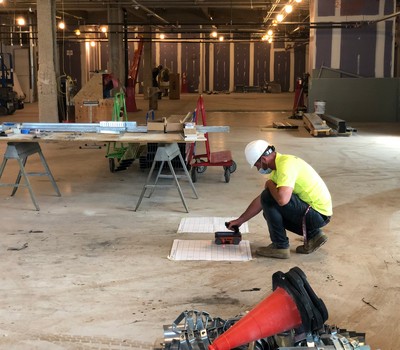Grasping RainierGPR Concrete Scanning: Necessary Advice
Grasping RainierGPR Concrete Scanning: Necessary Advice
Blog Article
Checking Out the Midst: A Comprehensive Guide to Concrete Scanning and Its Diverse Applications
In the world of building and infrastructure development, the precise procedure of concrete scanning holds a crucial function in ensuring the structural integrity and safety of projects. As innovation remains to evolve, the applications of concrete scanning have actually expanded far past simple surface-level analyses. From spotting rebar and post-tension cords to drawing up gaps and conduits hidden within concrete structures, the capacities of modern-day scanning methods are both crucial and remarkable. The real depth of concrete scanning's potential reaches also additionally, branching into unexpected fields and sparking ingenious remedies. The interconnected internet of possibilities that concrete scanning offers is not only interesting but additionally crucial for the development of numerous sectors.
Importance of Concrete Scanning
Comprehending the value of concrete scanning is crucial in guaranteeing the safety and stability of structures during construction and remodelling tasks. Concrete scanning utilizes advanced modern technologies such as ground-penetrating radar (GPR) and electro-magnetic induction to discover ingrained items, voids, or various other abnormalities within concrete structures.
Additionally, concrete scanning plays a critical role in making sure compliance with building regulations and policies that mandate the protection of existing architectural parts throughout construction activities. By properly mapping out the internal structure of concrete, scanning modern technologies allow building experts to make educated decisions that promote the structural stability and durability of buildings and infrastructure projects. Essentially, the value of concrete scanning exists in its ability to guard both the architectural integrity and the workers entailed in construction ventures.
Technologies Utilized in Concrete Scanning
Concrete scanning counts on innovative innovations such as ground-penetrating radar (GPR) and electro-magnetic induction to accurately discover embedded things and anomalies within concrete structures. Ground-penetrating radar operates by emitting high-frequency electro-magnetic waves into the concrete. When these waves run into different products or spaces within the concrete, they recover to the surface, permitting the GPR system to create an in-depth subsurface picture. This modern technology is particularly effective in locating rebar, post-tension cable televisions, avenues, and various other things installed in concrete.
Electro-magnetic induction, on the various other hand, functions by producing electromagnetic areas around a concrete structure via a transmitter coil. When metal items exist within the concrete, they interrupt these electromagnetic areas, causing eddy currents to move via the steel. By gauging the changes in the electromagnetic areas with a receiver coil, the system can determine the area of metal things in the concrete.
These advanced innovations play a critical function in non-destructive screening, ensuring the safety and stability of concrete structures our website in numerous industries.
Applications in Building And Construction Sector
Within the construction market, concrete scanning technology finds varied applications that boost job performance and security. In addition, concrete scanning is used for finding spaces, such as air pockets or locations of deterioration within concrete, which can endanger the general stamina of a framework. Concrete scanning plays a vital duty in quality control by verifying the thickness of concrete covers over reinforcement, guaranteeing conformity with layout requirements and standards.

Security Advantages of Concrete Scanning
In the realm of building and construction safety and security, the application learn this here now of concrete scanning technology presents a critical benefit in preemptively recognizing potential dangers and strengthening architectural integrity. By using innovative scanning approaches such as ground-penetrating radar (GPR) and electro-magnetic induction, building and construction teams can properly locate rebar, post-tension cables, conduits, and other covert items within concrete frameworks. This aggressive technique dramatically decreases the threat of unexpected strikes throughout drilling, reducing, or coring activities, thereby preventing expensive problems, injuries, and project delays.
Moreover, concrete scanning improves worker safety by offering real-time information regarding the architectural condition of concrete components. By resolving potential safety and security worries without delay, concrete scanning contributes to developing a safe and secure working atmosphere and reducing the probability of structural failures or mishaps on construction websites.
Future Patterns in Concrete Scanning
Emerging advancements in scanning innovation are poised to transform the area of concrete evaluation and evaluation. By harnessing the power of AI, these systems can analyze large amounts of information accumulated throughout scanning procedures to give more thorough and exact understandings into the problem of concrete structures.
One more considerable pattern is the growth of even more straightforward and portable scanning gadgets. Miniaturization of scanning tools enables less complicated access to restricted areas and remote areas, making inspections a lot more extensive and effective. In addition, improvements in wireless interaction innovations allow real-time data transfer and evaluation, assisting in quicker decision-making procedures.
Additionally, there is an expanding concentrate on sustainability in concrete scanning modern technologies - RainierGPR Concrete Scanning. Manufacturers are progressively incorporating eco-friendly products and see this site energy-efficient attributes into their tools to decrease environmental influence. These future trends are set to boost the efficiency, precision, and sustainability of concrete scanning practices, forming the sector's future landscape
Final Thought
In final thought, concrete scanning plays an essential duty in the building industry by ensuring the safety and effectiveness of different tasks. As technology breakthroughs, the future of concrete scanning holds appealing developments for boosting building and construction procedures.

Report this page